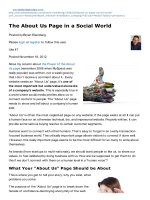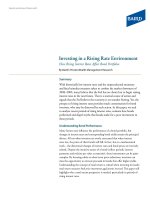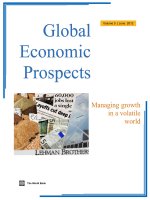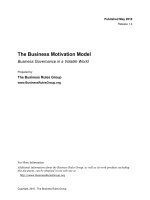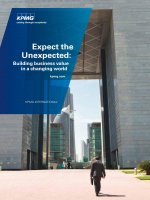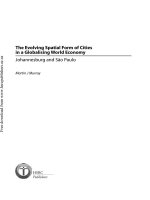Investing in a sustainable world
Bạn đang xem bản rút gọn của tài liệu. Xem và tải ngay bản đầy đủ của tài liệu tại đây (2.2 MB, 321 trang )
Advance Praise for Investing in a Sustainable World
by Matthew J. Kiernan, Ph.D.
“Matthew Kiernan has redefined global thinking around sustainable
finance and responsible investment. Without Kiernan’s work since the
late 1980s, the battle to drag institutional investors to the sustainability
table would have been immeasurably harder. Kiernan’s magic, as this
book gives witness to, is based on a deep intellect, the confidence to continually challenge the investment status quo and the ability to see fundamental changes in the markets well in advance of the mainstream.”
—Paul Clemants Hunt
Head, United Nations Environmental
Program Finance Initiative (UNEP FI),
Member of the Board
Principles for Responsible
Investment (PRI)
“If you’re a long-term investor, you have to care about sustainability, because it also equates to the ultimate sustainability of corporate earnings.
As a fund that invests across multiple generations, we believe that seeking short term gains at the expense of our planet and mankind will ultimately prove too costly to long-term corporate earnings and therefore
reduce our overall return. We at CalSTRS therefore take this book’s messages very much to heart.”
—Christopher Ailman, Chief Investment Officer CalSTRS
“In an age where financial risks are prowling “the street,” where complex
instruments defy evaluation, where profits are privatized and losses are
nationalized, Matthew Kiernan argues passionately—and convincingly—
that the financial markets can, and should, become an engine for improving environmental and social conditions rather than for undermining
them!”
—James L. Goodfellow F.C.A., Vice Chairman,
Deloitte & Touche (Canada)
“Matthew Kiernan has successfully scaled the Green Wall that often
separates those working in the financial and sustainability domains. His
latest book demystifies the concept of sustainable investment and provides
a compelling rationale for Wall Street to consider environmental and social criteria, not as afterthoughts but rather as core considerations in our
investment decision-making framework.”
—Abyd Karmali, Managing Director,
Merrill Lynch/Bank of America
“Why should savers watch passively as their nest eggs shrink? Matthew
Kiernan’s sparkling, breakthrough book explains why they don’t have to—
and how they can protect—and even expand—their investments.”
—Dr. Stephen Davis, Project Director and Fellow
Millstein Center for Corporate Governance & Performance
Yale School of Management
“Matthew Kiernan has turned his considerable experience and energy on
the ES themes into this lucid but sophisticated narrative. This is perfectly
timed to inform investors of the early mover advantage that is achievable
in this field.”
—Roger Urwin, Watson Wyatt Worldwide
“A colorful and personal analysis examining why the financial sector,
for the most part, has not understood that increasingly business success
will be shaped by both social and environmental challenges. Highly
recommended.”
—Bjorn Stigson, President,
World Business Council for Sustainable Development
“Investing in a Sustainable World explains the new sustainability paradigm driving the way investors, companies, and indeed society must now
think about value creation. Kiernan masterfully dissects the forces that
are transforming the landscape of capitalism, and he highlights trends that
investors must take into account and that corporate leaders simply cannot afford to ignore.”
—Dr. James C. Murphy, Director,
International Institute for Strategic Studies
“Climate change has the potential to be the dominant investment theme
of the 21st century. There are people who know about climate and
change and there are those who know about investing. In Matthew you
have someone who is passionately and effectively involved in both. That’s
why this should be at the top of your reading pile.”
—Alan Brown, Group Chief Investment Officer,
Schroders Investment Management
“Never boring, always provocative and challenging . . . mainstream investment professionals who ignore Matthew Kiernan’s messages here will
do so at their peril.”
—Tim Gardener, Global Head of Investment Strategy,
Mercer Investment Consulting
“True to form, this book is both provocative and opinionated. In a field
where much that is put to paper is either mind-numbingly technical or
just bland, this book is a refreshing change!”
—Dr. Raj Thamotheram, Head of Responsible Investments,
AXA Investment Management
“Investors can enhance their own competitiveness through innovations
that take closer account of environmental risks and rewards, recognizing
the growing nexus between finance and sustainable development. In this
important, timely, and compelling book, Kiernan shows how this can be
done, and why it is essential if we are to forge an economy the earth can
sustain indefinitely.”
—William L. Thomas, Counsel
Skadden, Arps, Slate, Meagher & Flom LLP
“Financial investment and sustainable development are allies, not adversaries. With Matthew Kiernan’s expertise, talent, persuasion, and sense of
humor in Investing in a Sustainable World, you’ll see that it’s a simple but
powerful idea.”
—Antoine de Salins, Member of the Board,
French Pensions Reserve Fund (FRR)
Praise for Matthew Kiernan’s previous book, The 11 Commandments of
21st Century Management:
“A brilliant and prescient analysis by one of the most original and visionary thinkers—and doers—I know. We ignore its messages at our peril.”
—Maurice F. Strong, 7-time Under-Secretary General of the
United Nations Senior Advisor to the President of the World Bank
This page intentionally left blank
INVESTING
IN A
SUSTAINABLE
WORLD
This page intentionally left blank
INVESTING
IN A
SUSTAINABLE
WORLD
Why GREEN Is the New Color of
Money on Wall Street
MATTHEW J. KIERNAN, PH.D.
New York • Atlanta • Brussels • Chicago • Mexico City • San Francisco
Shanghai • Tokyo • Toronto • Washington, D. C.
Special discounts on bulk quantities of AMACOM books are available to corporations, profesional associations, and other organizations. For details, contact Special Sales Department,
AMACOM, a division of American Management Association, 1601 Broadway, New York,
NY 10019. Tel: 212-903-8316. Fax: 212-903-8083.
E-mail:
Website: www.amacombooks.org/go/specialsales
To view all AMACOM titles go to: www.amacombooks.org
This publication is designed to provide accurate and authoritative information in regard to the subject matter covered. It is sold with the understanding that the publisher is not engaged in rendering
legal, accounting, or other professional service. If legal advice or other expert assistance is required, the services of a competent professional person should be sought. Although this book does
not specifically identify trademarked names, AMACOM uses them for editorial purposes only, with
no intention of trademark violation.
Library of Congress Cataloging-in-Publication Data
Kiernan, Matthew J.
Investing in a sustainable world : why GREEN is the new color of money on Wall Street /
Matthew J. Kiernan.
p. cm.
Includes index.
ISBN 978-0-8144-1092-9
1. Investments—Envioronmental aspects. 2. Investments—Social aspects. 3. Green
movement. 4. Social responsibility of business. 5. Investment analysis. I. Title. II. Title:
GREEN is the new color of money on Wall Street.
HF451.K54 2009
332.6—dc22
2008030023
© 2009 Matthew J. Kiernan
All rights reserved.
Printed in the United States of America.
This publication may not be reproduced, stored in a retrieval system, or transmitted in whole or in
part, in any form or by any means, electronic, mechanical, photocopying, recording, or otherwise,
without the prior written permission of AMACOM, a division of American Management Association, 1601 Broadway, New York, NY 10019.
This title is printed on 60# Thor Plus D56 Antique, which is processed chlorine free (PCF), meeting the requirements of American National Standard for Information Sciences-Permanence of Paper
(ANSI) Z39.48-1992, is Sustainable Forestry Initiative (SFI), and has 15% PCW (post-consumer
waste) content.
Printing number
10 9 8 7 6 5 4 3 2 1
Contents
Changing Finance and Financing Change:
The Genesis of This Book
Acknowledgments
xi
xx
1 Welcome to the Sustainable Investment Revolution!
2 What’s Taken Us So Long?: The Power of Intellectual and
1
Organizational Inertia
Perverse Outcomes and Lost Opportunities
But What Does the Evidence Really Say?
Toward a New Post modern, Sustainable Portfolio Theory
Why Does it All Matter, Anyway?: The State of the World
Sustainability and Competitive Advantage: The New
Corporate Imperative—and Some Success Stories
The Game-Changers. Part I: Collective Initiatives
The Game-Changers. Part II: The Individual Owners
of Capital
19
37
61
73
97
3
4
5
6
7
8
9
10 The Game-Changers. Part III: The Service Providers
11 Making It Happen
12 Some Final Thoughts
123
155
175
201
221
239
ix
x
INVESTING IN A SUSTAINABLE WORLD
Appendices: How It’s Actually Done
Appendix 1 "Intangible Value Assessment" of Petro China
Appendix 2 Carbon Beta Profile of Arcelor SA
Appendix 3 The “Global 100” Most Sustainable
Companies
Appendix 4 Top 20 Independent Sustainability Research
Providers (Thomson Extel)
Notes
References
Index
251
257
259
263
265
283
287
Changing Finance and
Financing Change:
The Genesis of This Book
n one sense, this book has taken more than 20 years to write; it is the
product of three different sets of experiences, dating back at least until
1987. At that time, I was a senior partner in the strategy consulting
practice of KPMG, the global accounting and consulting firm. I was part
of a team working on a billion-dollar privatization project in the forest
products sector. (This was so long ago that a billion dollars was actually
a reasonably significant amount of money!) The transaction came very,
very close to collapsing, primarily because of community and governmental concerns about the project’s potentially adverse environmental and
social impacts. Although I had completed a Master’s degree in environmental studies 15 years previously, this was actually my first practical,
real-world indication that environmental and social issues could readily
become critical business and financial issues as well.
The second set of experiences that directly catalyzed this book occurred several years later. I had left KPMG and had the unique opportunity to become a director with what is now the World Business Council
for Sustainable Development (WBCSD) in Geneva, Switzerland. Founded
in 1989 and led by Swiss industrialist and billionaire Stephan Schmidheiny, the WBCSD had been given the somewhat daunting task of representing “the private sector” and advising the Secretary General of the
UN Earth Summit in Rio de Janeiro in 1992. In short order, Schmidheiny had managed to assemble a “dream team” of global industry titans:
I
xi
xii
INVESTING IN A SUSTAINABLE WORLD
the chairmen or CEOs of leading companies, such as DuPont, Royal
Dutch/Shell, Mitsubishi, Volkswagen, and Dow Chemical.
Despite having this “who’s who” of global business luminaries in
tow, however, Schmidheiny could not in the early days recruit a single
banker or financier to join the group! Normally, in my limited experience, invitations from multibillionaires are reasonably well received by
bank chairmen. This is particularly true when the invitation also includes
an 18-month opportunity to rub shoulders with more than two dozen
heads of the world’s leading industrial companies (i.e., mouth-wateringly
attractive potential banking clients!) Notwithstanding these commercial
inducements—not to mention a fascinating, worthwhile, and totally
unprecedented group challenge—Schmidheiny was turned down by the
chairmen of several of the largest banks in the world. The reason? At that
point, the bankers literally could not see the connection between what
they did for a living and the future of the planet. As one bank chairman
put it at the time: “But we don’t cut down any trees here at the bank;
your mission has nothing to do with us.” Well, there you have it, then!
Silly us for even asking!
Lacking a proper global bank chairman, it initially fell to me to coordinate the work of the WBCSD’s task force on capital markets. It was
a galvanizing, breakthrough experience for me. For the first time, I began
to understand the truly transformational potential of the global financial
markets. They were, after all, the providers of the financial “oxygen supply” for most of the world’s largest companies.
I reasoned that even if major corporations had not in fact created
75 percent of the world’s environmental and social problems, they certainly represented at least 75 percent of the potential solutions. But in
order for this to happen, their behavior simply had to change. I know of
only two sure-fire ways to turn an industrial CEO into a sustainability
advocate and practitioner. One is to ensure that his 16-year-old daughter consistently hectors him at breakfast about the deplorable environmental and social track record of his company. This is highly effective,
but very difficult to pull off on any kind of a large scale!
The other way would be to send him a clear message through the
financial markets. If his company’s share price suffered or desired bank
loans became more expensive or even unavailable altogether because of
significant environmentally or socially driven risks or poor performance,
that would get his attention—and quickly! Now that could achieve a largescale systematic impact!
CHANGING FINANCE AND FINANCING CHANGE
xiii
First, however, there were two major obstacles to overcome:
•
•
Investors first needed to be convinced that environmental and social
(ES) risk, performance, and strategic positioning could actually be
financially and competitively material; and
Investors would need access to credible, financially oriented company
research, so that they could begin to distinguish corporate leaders from
laggards and then act on that information.
If the tepid response to Schmidheiny’s overtures to the global bank chairmen was anything to go by, it promised to be a long, uphill struggle indeed! Neither key precondition could be achieved quickly or easily, but
someone had to start somewhere. I decided that the “somebody” might
as well be me and that the “somewhere” needed to be the creation of a
totally different kind of investment research company.
That new research vehicle turned out to be Innovest Strategic Value
Advisors, about which we will hear more in Chapter 10.1 The 15-plus
years that my colleagues and I have spent since then helping build Innovest’s global business have provided the third set of experiences that directly catalyzed this book. Over that time, my colleagues and I researched
both the sustainability and financial performance of thousands of companies from all over the world. In some cases, we tracked them for a full
decade; in virtually all cases, it was for a period of at least 5 years. The
results of that research were unequivocal: companies with superior performance and positioning on “sustainability” (i.e., environmental and
social) issues achieved, on average, superior financial returns. In the
course of that 15-year period, I have personally “pitched” the sustainable
investment thesis to hundreds of trustees at pension funds and foundations, to chief investment officers and senior investment bankers, and to
pension fund consultants all over the world. The results of all of these
interactions have convinced me of six fundamental “truths”:
1. Environmental and social issues and problems are not “just” problems
on those levels alone; they are also absolutely—and increasingly—
critical to the competitiveness and financial performance of both
individual companies and the broader economies and societies in
which they operate.
2. Any serious attempt to make a systematic impact on global environmental and social problems will absolutely require the fundamental
xiv
3.
4.
5.
6.
INVESTING IN A SUSTAINABLE WORLD
reengineering of the very “DNA” of the capital markets. Those issues
must be brought from the periphery of the investment decisionmaking process—at best—into its very center. Nothing less comprehensive could possibly suffice.
At present, most of the major players in the financial markets remain
blissfully, if not determinedly, unaware of the close connection between companies’ ES performances and their financial results.2 And
the vast majority of those few who have even considered such a connection are highly skeptical about it.
This lack of awareness—or even hostility—could be costing a lot of
people a lot of money. Contrary to widespread belief among “professional” investors, the failure to systematically consider ES risks
and opportunities in investment decisions is very likely impoverishing, not improving, their financial results.
This, in turn, means that ordinary investors and savers are essentially
being short changed. There is a better than even chance that the
managers of their pension plans and mutual funds are not performing as well as they could be. In brief, people’s money is being left on
the table.
For this situation to improve significantly, all of the key actors in the
investment “food chain” will need to be convinced of the potential
materiality of ES factors to companies’ financial performances. This
includes the asset owners and their trustees and fiduciaries, the asset
managers, and the researchers, analysts, and consultants who advise
them all.
Providing the arguments and evidence necessary to do that convincing is
the primary purpose of this book. It is designed to accomplish at least
four major objectives:
•
•
•
To provide a compelling investment case—not necessarily an ethical
one—for integrating environmental and social considerations directly
into the investment process;
To attempt to explain why, despite the powerful logic for doing so,
this practice remains overwhelmingly the exception rather than the
rule;
To provide concrete examples of some leading-edge organizations
that are pioneering new approaches—and several that should be but
are not; and
CHANGING FINANCE AND FINANCING CHANGE
•
xv
To provide both the conceptual and practical tools necessary to equip
investors—both institutional and individual—to “future-proof” their
portfolios by integrating environmental and social factors.
It will, of course, be for the reader to decide how well or poorly those
objectives have been met. I, for one, have become absolutely convinced
of at least one thing, however: that the systematic integration—or at least
consideration—of ES factors has now become an absolute imperative.
Both financial returns and the fate of the planet depend on it.
The book’s intended audience is necessarily a broad one: ordinary
savers and investors (“Main Street”), professional money managers and
investment banks (“Wall Street”), the trustees, fiduciaries, and investment consultants for pension funds, endowments, and foundations, and
their professional staffs. It is also hoped that the book will be of interest
and value to the executives, boards, and staffs of the companies that investors are evaluating and considering. At this stage of the game, the corporations are, on the whole, far ahead of their investors in this regard,
but I hope that even they will find some new insights and ideas in this
book that will help them do their jobs even better.
There is one additional—and powerful—motivation for writing
this book. I hope that it will help to fill a critically important void that I
believe still exists in the burgeoning literature about sustainability. In addition to a constant barrage of information in the daily media and popular press, a number of excellent books have been written on the subject
over the past few years. At least two of them are being published virtually
contemporaneously with this one. They are by world-class writers and
thinkers Tom Friedman and Peter Senge.3 Those books focus on a number of the key elements in the “value chain of change”—government,
private sector corporations, nongovernmental organizations, and civil society. While each of these sets of actors undeniably has a major role to
play in the Sustainability Revolution, none, in my view, has anything close
to the overwhelming, transformational power of investors and the capital
markets. The financial markets constitute the “financial oxygen supply”
for the major corporations that determine so many of the actual sustainability impacts and outcomes on the ground. Despite this, however, the
sustainability literature has remained curiously silent on both the current
and potential role of finance and investors. Since I firmly believe them to
be the single most critical variable in the equation, this book is intended
to focus attention there, where I believe it is long overdue.
xvi
INVESTING IN A SUSTAINABLE WORLD
A “Road Map” to the Book
Chapter 1 introduces the reader to the brave new world of investing in
the first decade of the twenty-first century. As we shall see, it is a world
increasingly being shaped by an unprecedented confluence of powerful
global megatrends. Those trends pose fundamental challenges to a number
of deeply embedded orthodoxies in investment thinking and practice.
Among the most fundamental and transformational of those emerging
trends is the inexorable increase in the importance of ES factors. Investors who fail or refuse to come to grips with them are likely to be
increasingly marginalized—and financially unsuccessful.
Chapter 2 explores the reasons why, despite their growing importance, ES factors have historically received such short shrift from investment experts. A series of powerful myths and misconceptions has
effectively blinded them to both the risks and the opportunities that ES
factors can present. It is hoped that a better understanding of both the
genesis and the anatomy of that mythology will help to accelerate its
repudiation and disappearance.
Chapter 3 looks at some of the rather bizarre real-world results of
those cognitive blinders. It is a litany of both perverse behavior and significant lost opportunities, and it will surprise even sustainability “experts”
who will, logically enough, have presumed such things to be impossible
in this day and age.
Chapter 4 then takes a look at what the evidence actually says about
the impact of including sustainability factors. Setting the record straight
is vitally important here. For far too long—indeed, for decades now—
investment professionals have solemnly reassured their clients that ES
factors were at best irrelevant and at worst actively injurious to their financial returns. On those rare occasions where their clients might dare to
push back, they were almost invariably assured that there is a vast body
of financial performance “evidence” to support the advisor’s or money
manager’s contention. (This is often accomplished by the additional,
patronizing implication that this evidence is so abstruse and difficult to
comprehend that only a trained investment professional could possibly
fathom it. “Just trust me.”) Well, it turns out that while there is indeed
a large and growing body of both academic and empirical evidence on
the subject, most of it points to a positive, rather than a negative, impact
from considering ES factors. It is, we believe, vitally important to put the
real evidence on the table, to counter the widespread misconceptions to
the contrary. And what is even more important is that regardless of what
CHANGING FINANCE AND FINANCING CHANGE
xvii
the historical evidence says, the major megatrends currently reshaping the
global investment environment make it virtually certain that this positive
impact will become even greater as we go forward.
Chapter 5 attempts to outline the conceptual underpinnings of a
new “theory” or approach to “sustainable investing”—that is, investing as
if environmental and social factors actually matter. At this point the reader
might object: “but isn’t there already an entire, well-established school of
‘socially responsible’ investing (SRI), for which ES issues are absolutely
central?” Quite true, but they remain a relatively peripheral, statistically
small segment of the market, and anyway, those investors already “get it”
and need no convincing from us about the saliency of ES factors.
Instead, this book is primarily directed at the other 95 percent of
the investment world—those whose primary concerns are good financial
returns, a college education for their kids, and a secure retirement. They
likely fall into one of two categories: those who have never even heard
of or considered the notion of integrating ES factors in their investment
strategies, and those who have considered it and rejected it, often on
the advice of “expert” advisors. It is primarily for them that this book is
written. Chapter 5 provides a conceptual and theoretical foundation for
sustainable investing and places it in the broader context of overall investment theory. We present here a new, postmodern theory of investing.
Chapter 6 is intended to take a step back and remind us why all of
this matters in the first place. It provides a quick “crash course” tutorial
on where we actually stand today—and are likely to stand tomorrow—
with respect to the major environmental and social challenges of our time.
We examine briefly critical sustainability issues, such as climate change, air
and water pollution, human and labor rights, access to affordable medicines in emerging markets, and global poverty and income inequality. This
chapter argues that we simply cannot afford—environmentally, socially,
or financially—to continue along our current investment trajectories.
Chapter 7 shifts gears and perspectives somewhat and focuses on
the kinds of companies that sustainability investors will want to consider.
It demonstrates how and why ES issues have become increasingly critical
to companies’ competitive success. It also highlights the opportunity/
upside part of the ES equation for companies. Too many boards and
executive teams, like their investors, have tended to view ES issues as
primarily—if not exclusively—sources of downside risk. Chapter 7 uses
real-world examples from a wide variety of both countries and industry
sectors of innovative companies that have both recognized and seized some
of the myriad new business opportunities being created by the “Sustainable
xviii
INVESTING IN A SUSTAINABLE WORLD
Investment Revolution.” These examples should be illuminating for both
company leaders and investors alike, and, for the latter, should point them
toward the sorts of twenty-first century companies for which they and
their investment advisors should be searching constantly. This chapter is
intended to put to rest the widely held belief that it is possible to choose to
invest either in more “sustainable” companies or financial outperformers,
but not both. It provides proof that this is possible and reinforces some
of the aggregated statistical findings of Chapter 4.
The next three chapters (8–10) focus on the “Game-Changers”—
the cutting-edge organizations and individuals who are currently leading the Sustainable Investment Revolution. They are all from different
perspectives, but with dizzying speed, building the organizational and
conceptual infrastructure of this emerging new investment universe. Chapter 8 focuses on a number of examples of unprecedented collaborations
among large and diverse groups of investors and other stakeholders.
Chapter 9 profiles individual asset owners—pension funds, endowments, and foundations—that are pioneering new ways of integrating
environmental and social factors into their investment strategies and
decisions. Chapter 10 looks at the service providers—the consultants,
advisors, researchers, and money managers—who are helping redefine
both leading-edge thinking and practice in this emerging new investment field. Chapters 8, 9, and 10 together are meant to provide positive
proof that sustainability investment can indeed be done, and done successfully and profitability.
Chapter 11 proceeds from the optimistic assumption that the reader
will by that point be convinced that environmental and social factors
must—and can—in fact be systematically considered in any successful,
forward-looking investment strategy. It is intended as a bit of a “how-to”
manual; once convinced of the merits of sustainable investing, the reader
will still need some new tools to actually get it done. It is hoped that
Chapter 11 can help provide at least some of them. For some specific
investment decisions, upon closer examination, it may turn out that ES
factors simply do not in fact loom large. If so, fair enough; the important
point is that they should at least be seriously considered before they are
rejected out of hand as immaterial. At present this is emphatically not the
case, but it should be and it can be.
Chapter 12 provides some concluding thoughts and a reminder that
“sustainability”—and therefore sustainability investment—is a dynamic,
moving target, with the “bar” being raised constantly. Complacency has
no place in the vocabulary of the sustainability investor.
CHANGING FINANCE AND FINANCING CHANGE
xix
At the end of the day, though, this book is really all about awareness and empowerment. It is intended to provide readers with both the
conceptual and practical tools to make a real difference with their investment assets. Most investors and their advisors are not yet fully aware
of the potential that they have to combine environmental, social, and
financial objectives at the same time. Once this realization emerges, the
potential for wholesale global transformation will truly have arrived. The
financial markets will have become an engine for improving environmental and social conditions rather than for undermining them!
So, welcome to the Sustainable Investment Revolution! Investors
of the world unite! You have nothing to lose but your philosophical and
intellectual chains.
Acknowledgments
This book was written in a somewhat unconventional fashion, with direct
implications for the Acknowledgments. No one reviewed draft chapters
and gave helpful suggestions; in fairness, they were never asked to. Indeed,
no one saw so much as a single paragraph until this book was completed.
For better or worse, this approach gives new meaning to the classic bromide that “any errors or mistakes are the responsibility of the author.”
That’s for sure! As a result, the usual acknowledgments to the kind souls
who enriched the book by commenting on it cannot truthfully be made
here. That is not, however, to imply that I am without intellectual debts;
far from it. Individuals far too numerous to mention (some of them
perhaps unknowingly) have contributed to my ongoing and sometimes
painful education over the past 15 years—roughly the gestation period
of this book.
Chief among them are my colleagues and friends at Innovest Strategic Value Advisors. First among equals are Hewson Baltzell, Andy White,
and Pierre Trevet, as well as my former Innovest colleague Martin Whittaker. I also owe a huge debt to my talented research assistants: Priti
Shokeen, Nick Brown, Simon Gargonne, and Darwin Fletcher. Their
work on the dozens of case studies was literally indispensable.
I am also indebted to my literary agent Cynthia Zigmund, who
engineered what was for me a match made in heaven with my publisher,
AMACOM. At AMACOM, I am particularly grateful to American Management Association CEO Ed Reilly and AMACOM President Hank
Kennedy for their vision, enthusiasm, and consistent support throughout the project. My editor, Bob Shuman, was unfailingly both accessible
and helpful, and both I and the reader are the beneficiaries of his many
contributions. Barbara Chernow and Andy Ambraziejus also made major
contributions to both the quality and the timely emergence of the book;
my thanks to both of them!
Finally, I will always be in the debt of my family: my wife Catherine
Harris and our children—now young adults—Susannah and Patrick. All
three are a constant inspiration. And, for Susannah, additional special
thanks for the expert and patient shepherding of the manuscript.
xx
Chapter 1
Welcome to the Sustainable
Investment Revolution!
It is becoming increasingly clear that sustainable development will
be one of the major drivers of industrial change over the next 50
years, and that there is a growing demand from both companies
and institutional investors to understand its financial impacts.
—COLIN MONKS, HEAD OF EUROPEAN EQUITY RESEARCH, HSBC
The Imperative—and the Opportunity—
for Twenty-First Century Investors
The world of international investment is now on the cusp of a revolution
more profound than anything it has witnessed in literally decades. Hardnosed Wall Street investment bankers, not a species previously noted for
excessive hand wringing about environmental quality, social justice, or
the fate of the planet, are suddenly writing reports about climate change,
water scarcity, human rights in China, and a host of other topics that
they have been studiously avoiding for most of their careers. Large pension funds from Sacramento to Bangkok, under strict fiduciary obligations
1
2
INVESTING IN A SUSTAINABLE WORLD
to focus only on issues directly material to investment performance, are
now beginning to pay close attention to these same issues and to allocate
money to “sustainability” funds for the first time.
In less than 18 months, the United Nations Principles for Responsible Investment have already attracted more than 380 signatories, with
combined assets under management of over $14 trillion. Investment banks,
such as Goldman Sachs and JP Morgan, are pouring billions of dollars
into clean technology companies, carbon trading, and other investment
opportunities driven by the Sustainable Investment Revolution. A global
investor coalition focused on climate change, the Carbon Disclosure
Project, has now attracted supporters with over 55 trillion dollars worth
of assets in only its sixth year of existence. This represents well over half
of all of the professionally managed financial assets in the world. What
is more, over 20 major institutional investors from seven countries, with
more than $2 trillion in combined assets under management, are already
redirecting some of their research budgets toward sustainability issues
through a collaborative initiative called the Enhanced Analytics Initiative.
What on earth is going on here? What’s going on here is, quite simply,
the Sustainable Investment Revolution. I firmly believe that over time,
this Revolution will have as great an economic impact and be viewed as
being at least as transformational as the development of the Internet or,
before that, the advent of the railroads and electricity.
Like its predecessors, the Sustainable Investment Revolution is driving a worldwide industrial restructuring, radically changing the very
basis of competitive advantage for companies and, therefore, for their investors. Like any other global restructuring, this new one will create both
new winners and new losers. This book is predicated on the premise that
it will strongly behoove twenty-first century investors to try to figure out
which companies are which!
But why are investors acting this way—at least some of them? Because it is now increasingly evident that the “tried-and-tested” approaches
that have dominated the investment field for the past 20 years are simply inadequate to cope with the complexities, subtleties, and competitive
turbulence of the early twenty-first century. Contrary to the popular and
deeply held belief among investment “experts,” sustainability or ES issues
such as climate change, air and water pollution, and affordable access to
medicines in emerging markets do indeed matter to companies. They are
already directly affecting companies’ competitiveness, profitability, and
ultimately their share price performance. Think, for example, of the runaway commercial and reputational success of the Toyota Prius hybrid car
WELCOME TO THE SUSTAINABLE INVESTMENT REVOLUTION!
3
and the frantic if fatally belated efforts of Detroit’s “Big 3” automakers
to catch up. Think too about GE’s multibillion dollar Ecomagination initiative and its galvanizing impact on that industrial giant. Consider the
worldwide attempt by Walmart’s leadership to make quantum improvements in environmental efficiency—both within the company itself and
across its enormous, worldwide supply chain. In the process, they are
slowly but surely turning Walmart from global pariah into an exemplar
of environmental leadership.
While sustainability is far from being a magic bullet or panacea for
corporate competitiveness, for a growing number of top performers, it
has allowed them to gain market share, create attractive new products
and services, create and enhance customer loyalty, recruit, retain, and
motivate top talent, reduce energy costs, and reduce the risk of both customer backlash and litigation.1
All of these attributes are the hallmarks of better managed, more farsighted, agile, and adaptable companies. Today’s—and especially tomorrow’s
—investors will increasingly need to learn how to find them, and the traditional investment tools and approaches, on which they have relied for
decades, are becoming less and less helpful in doing so.
What may be even more remarkable than the velocity and extent
of this revolution, however, is the fact that it has been so long in coming,
despite all of the warning signs. Indeed, notwithstanding the pioneering
efforts of a few brave “heretics” willing to challenge Wall Street and City
of London orthodoxy, a surprisingly—and disturbingly—large percentage
of major investors continue even now to act as if this investment revolution had still not begun. But this is all beginning to change.
Global hypercompetition, accelerated by a “perfect storm” convergence of a number of powerful global megatrends, is creating both challenges and opportunities for investors that are quite literally without
precedent. To confront those challenges and seize the opportunities,
investors will need both a radically different mindset and an entirely new
arsenal of analytical tools. This book is intended to contribute to both.
To date, however, the majority of large institutional investors have
for the most part been sleepwalking through the early part of the twentyfirst century—having already dozed through the latter part of the previous one as well. Hobbled by grossly obsolete mental models and a set of
“conventional wisdoms” that turns out to be anything but, they have until very recently missed out almost entirely on what is arguably the most
extraordinary economic and sociopolitical transformation of the past 30
years—the Sustainability Revolution.2
4
INVESTING IN A SUSTAINABLE WORLD
The logic of “sustainability investment” is, in fact, disarmingly
straightforward. Indeed, it should be obvious to any reasonably literate
10-year-old child: companies capable of managing ES challenges better than their competitors are quite likely to be better-managed companies, period. It therefore follows logically that they are likely to be
superior financial performers as well. (The real tragedy here, of course
—with due acknowledgment to Marx—Groucho, that is—is that we
rarely if ever have the luxury of having a 10-year-old child with us in
JP Morgan’s or Goldman Sachs’s boardroom when we desperately need
one!).
Let me be clear from the outset: this book is emphatically not about
traditional “ethical” or “socially responsible” investment (SRI). That
approach, driven largely by investors’ personal values, will always and deservedly have its place, and it has enjoyed a long and largely successful
run, particularly in the retail (individual investor) marketplace, and especially in the United States and Britain. But traditional SRI’s ability
to penetrate the mainstream, institutional marketplace, where the really
big money is, will always remain severely limited, in my view. Very few
major institutional investors wish to step onto the rather slippery conceptual slope of values-based investing. Should they support—or oppose
—contraception, genetically modified foods, animal testing, investing
in Sudan, or any of the myriad value judgments that a traditional SRI
not only demands but actually thrives on? Traditional SRI holds very
little appeal for those unwilling or unable to make those kinds of value
judgments, and since that describes well over 95 percent of the USD 60
trillion in professionally managed assets worldwide, I fear that traditional
or “neoclassical” SRI will always be confined to a somewhat marginal
role.
Since definitions of what is truly “ethical” or “socially responsible”
behavior—and therefore investing—vary widely, getting a handle on the
actual size of the conventional SRI market is a highly difficult and controversial task. While SRI partisans regularly advance much larger numbers, my own back-of-the-envelope calculations would put it at well under
5 percent of the total managed assets worldwide—at the very most. The
focus of this book, by contrast, is on the other 95 percent of investors:
those whose primary concern is maximizing their risk-adjusted financial
returns and finding the best managed, most agile, and far-sighted companies they can lay their hands on in which to invest their retirement
savings.
